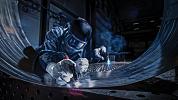- FMA
- The Fabricator
- FABTECH
- Canadian Metalworking
The Electric Press Brake: How It Works
- September 9, 2011
- News Release
- Fabricating
Canadian Industrial Machinery asked Safan Area Export Manager Mauricio Gutierrez Matta to explain the technology behind electric press brakes. Here's what he had to say.
CIM: How is the top beam moved?
Matta: The beam is moved downward by a belt and pulley system in combination with the servomotor, and return movement of the upper beam is by springs.
CIM: How is force applied evenly?
Matta: Because the pulleys are divided over the full length of the upper beam, [even force can be applied].
CIM: Is a crowning table necessary?
Matta: No. The force is equally divided along the upper beam and the lower beam and equally pressed, contrary to conventional machines that are pressed only at the edges of the beam by the hydraulic cylinders.
A crowning table is necessary if the customer wants to bend with extreme load on the machine (for example, V width is less than times the sheet thickness). So far, 95 percent of our end users have not required a crowning table.
CIM: How is inertia reduced in electric press brakes?
Matta: Due to the pulley principle and the innovative construction of our lower beam, inertia does not influence the parallelism between the pressing surfaces of the lower and upper beam.
CIM: How are movement and bending speed produced and controlled?
Matta: The servomotors are synchronized with linear encoders on both sides of the upper beam (Y1 and Y2).
CIM: How important is the safety system on this press brake, and how is it used?
Matta: The programmable safety light guard is integrated in the press brake control and fits the latest European CE safety regulations. [Editor's Note: The Safan E-Brake also complies with the CSA Z-142 safety standard.] Because of the integration with our own press brake control, the light guard can be used in different modes and can be programmed per bending step. Due to this, the E-Brake can reduce cycle time by 30 percent or more with very high standards of safety.
CIM: What is the difference between the O-frame construction and the C-frame press brake?
Matta: Because of the O frame, the machine has full access to the backgauge over the full bending length at the back side of the machine. Moreover, the upper beam is able to move straight vertically under high bending forces.
CIM: How can downtime and maintenance be reduced?
Matta: The absence of oil and instability of maintenance-demanding hydraulic valves [reduce downtime and maintenance].
CIM: How is energy consumption reduced?
Matta: When the machine is idle, for example during setup of tools, programming new parts, and removing bent parts, the energy consumption is reduced to a minimum. This means about 50 percent less energy is used compared to conventional hydraulic press brakes.
CIM: What is the demand for this type of press brake?
Matta: The need for ecologically friendly and energy-saving machinery is making our technology more and more in demand.
subscribe now


Keep up to date with the latest news, events, and technology for all things metal from our pair of monthly magazines written specifically for Canadian manufacturers!
Start Your Free Subscription- Industry Events
Automate 2024
- May 6 - 9, 2024
- Chicago, IL
ANCA Open House
- May 7 - 8, 2024
- Wixom, MI
17th annual Joint Open House
- May 8 - 9, 2024
- Oakville and Mississauga, ON Canada
MME Saskatoon
- May 28, 2024
- Saskatoon, SK Canada
CME's Health & Safety Symposium for Manufacturers
- May 29, 2024
- Mississauga, ON Canada





















